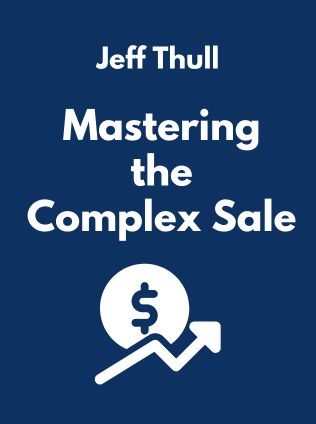
Mastering the Complex Sale
How to Compete and Win When the Stakes are High!
By Jeff Thull
Published 03/2010
About the Author
Jeff Thull is the President, CEO, and founder of Prime Resource Group, a leading consultancy that delivers optimal market strategies for business success. Thull's clients include major corporations such as 3M, Microsoft, Siemens, Citicorp, and IBM. As a business strategist, consultant, and speaker, he has dedicated his career to transforming the conventional sales process into a customer-centric approach that leads to high-quality decision-making and long-term relationships. His expertise in complex sales is encapsulated in his groundbreaking work, Mastering the Complex Sale, where he offers a practical and proven approach called Diagnostic Business Development, also known as the Prime Process.
Main Idea
The central premise of Mastering the Complex Sale is the need for a paradigm shift in how sales professionals approach business-to-business (B2B) and business-to-government (B2G) transactions. In today's complex and competitive marketplace, traditional sales techniques fall short. Jeff Thull advocates for a smarter way to sell, one that moves away from the conventional sales pitch and towards a high-quality decision-making process that customers value. This approach transforms salespeople from mere vendors into valued business partners, shifting the sales process from premature presentations to mutual confirmation. Thull's Diagnostic Business Development process emphasizes a diagnostic-based, customer-centric approach, which he argues is the key to mastering complex sales.
Table of Contents
- The High Stakes World of Complex Sales
- Four Phases of the Prime Process
- Leading the Complex Sales Organization
- Turning Organizational Strategy into Sales Results
The High Stakes World of Complex Sales
Complex sales are characterized by transactions that involve multiple stakeholders, perspectives, and often span across various companies and cultures. These sales cycles can range from days to years and require significant investment in time and resources. Unlike simple sales, the complex sale involves a chain of interrelated decisions impacting multiple departments and disciplines within the customer's organization. This means there is no single decision-maker; instead, multiple decision-makers, each with their own perspectives and self-interests, influence the process.
Thull identifies two main forces squeezing sales professionals: commoditization and increasing complexity. Commoditization devalues differences between goods and services, reducing decisions to the lowest common denominator—price. Complexity arises from the intricate structures of organizations, the demand for more complex relationships, and the challenging business environments customers face. The conventional response to these forces is to "sell harder," but this only exacerbates the problem, leading salespeople into traps that hinder their success.
Trapped by Conventional Thinking
Thull describes three primary traps in conventional selling:
- The Assumption Trap: Salespeople rely on customers' decision-making processes, assuming they are high-quality, which often is not the case. This leads to erroneous beliefs about customers' ability to understand their problems and evaluate solutions.
- The Presentation Trap: Overemphasis on presentation neglects the customer's world, the source of credibility, differentiation, and decision criteria. This creates a disconnect between the customer and the solution.
- The Adversarial Trap: The focus on presentations leads to misunderstandings and adversarial relationships, impeding trust and cooperation.
A New Approach to Complex Sales
Top-performing salespeople need a dependable system, skills, and discipline. Thull introduces the Prime Process, a diagnostic business development approach that provides a high-quality decision process for customers. The Prime Process transforms salespeople into leaders who guide customers through the decision-making process. This approach is built on three pillars:
- Recognizing that buying is about customers making a decision to change.
- Focusing on business development and thinking like business owners.
- Building customer relationships based on professionalism, trust, and cooperation.
Four Phases of the Prime Process
The Prime Process consists of four phases: Discover, Diagnose, Design, and Deliver. Each phase addresses specific challenges in the complex sales environment and guides sales professionals to provide a high-quality decision process for their customers.
Discover the Prime Customer
The Discover phase emphasizes research and preparation. Salespeople identify and engage customers who have the highest probability of change. This phase includes pre-contact research, preparation of an engagement strategy, and the initial contact. The goal is to build a foundation of professionalism, mutual respect, and trust.
In this phase, salespeople should look for reasons to disqualify prospects who are unlikely to become customers, thus saving time and resources for both parties. The perception of professionalism is crucial here, as it sets the tone for the relationship.
Diagnose the Complex Problem
In the Diagnose phase, salespeople help customers understand the inefficiencies and performance gaps they face. This phase involves hyperqualification, where the extent and financial impact of the customer's problems are determined. Thull emphasizes that true diagnosis is not subordinate to selling solutions but is about maximizing customers' objective awareness of their dissatisfaction.
This phase diverges significantly from conventional selling, as it is during a well-executed diagnostic process that most customers decide to change and buy. Salespeople deepen their understanding of the customer's business and collaboratively quantify the problem's cost. Establishing credibility is key, as salespeople must identify and communicate the sources and intensity of customers' problems without altering the customer's reality to fit their own needs.
Design the Complex Solution
The Design phase involves creating and understanding the solution collaboratively. Unlike conventional sales presentations, this phase is interactive, helping customers sort through expectations and alternatives to arrive at an optimal solution. The goal is to minimize the customer's risk of change and optimize return on investment.
Sign up for FREE and get access to 1,400+ books summaries.
You May Also Like
The Lean Startup
How Today's Entrepreneurs Use Continuous Innovation to Create Radically Successful Businesses
By Eric RiesWho Moved My Cheese?
An Amazing Way to Deal with Change in Your Work and in Your Life
By Spencer Johnson, M.D.Make Your Bed
Little Things That Can Change Your Life...And Maybe the World
By William H. McRavenThe Ride of a Lifetime
Lessons Learned from 15 Years as CEO of the Walt Disney Company
By Robert Iger



















